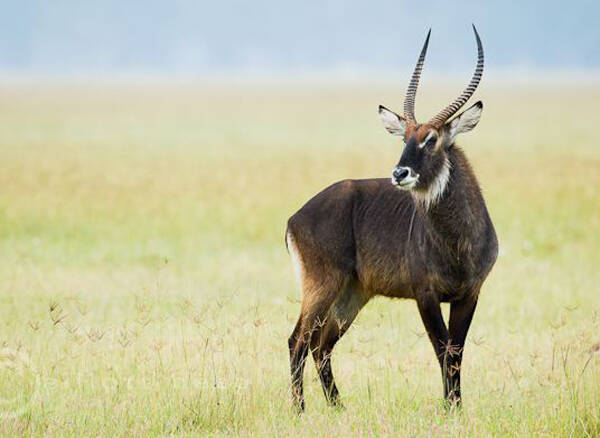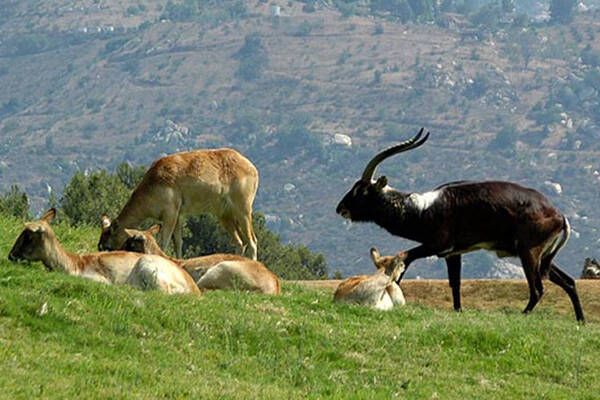Kobus megaceros
IUCN
LCBasic Information
Scientific classification
- name:Kobus megaceros
- Scientific Name:Nile waterbuck, Nile lechwe, Nile short-nosed lechwe, Nile lechwe, Nile blackbuck, Bighorn lechwe
- Outline:Ungulata
- Family:Artiodactyla Bovidae Koi
Vital signs
- length:135-165cm
- Weight:60-120kg
- lifetime:10-11.5years
Feature
Mature males have a white "saddle" pattern on their shoulders and white markings on their face.
Distribution and Habitat
Found only in South Sudan and Ethiopia. The largest part of its range occurs in the "Sudd" swamps along the White Nile and Sobat rivers. Smaller numbers occur in the Machar swamps near the Ethiopian border, extending slightly into Gambella National Park in southwestern Ethiopia, where its survival is very precarious due to expanding human activities. An aerial survey of the Sudd River during the dry season in 2007 recorded widespread distribution along the banks of the White Nile and Sobat rivers, tributaries of the Nile.
Inhabits short grasses, tall reeds, and sugarcane scrub. Restricted to seasonally flooded swamps and grasslands within the wetlands of South Sudan and southwestern Ethiopia. Almost always found at the edges of shallower and deeper swamps, often found in shallow water 10-40 cm deep.
Appearance
Nile waterbuck males have lyre-shaped horns that are 48-87 cm long. Males average 165 cm in length, 100-105 cm at the shoulder, and weigh between 90-120 kg. Females average 135 cm in length, 80-85 cm at the shoulder, and weigh 60-90 kg. The species exhibits extreme sexual dimorphism, to the extent that males and females appear to belong to different species. Males and females can be easily distinguished based on the fur color, body size, and ornamentation. However, both sexes have long, thick hair on their heads, slender, narrow hooves, short noses, and a long tail that is 40-50 m in length. Older males are dark brown with a white spot behind the horns. This white spot connects to the neck to form a white band that widens at the withers. Females are pale yellow and have no horns. Young males look like females at 2 or 3 years of age. Thereafter, the fur color changes and the horns begin to grow.
Details
Nile Waterbuck (scientific name: Kobus megaceros) is also known as Nile Lechwe in English. There is no subspecies.

Nile Waterbuck is a crepuscular animal, a social animal that lives in groups but has a sense of territory. It forms groups of 50-500 individuals. In a herd, three social classes are formed: young and females, single young males, and mature males with territories. The species lives in areas with water and wetlands, so during the rainy season, their populations are spread out near water sources. During the dry season, the animals gather around the few remaining water sources. They rest in areas above water level such as dry riverbanks, sandbanks, islands, and flee to the water when disturbed. They are good swimmers, but prefer wading in shallow water.
Nile waterbucks have a herd mating system in which only the dominant male is sexually active. Mating begins with a distinctive sign form. The male places his head on the ground and urinates on his throat and cheeks. He then mates after rubbing his feces-dripping whiskers on the female's forehead and buttocks. The mating system is polygamous, and the gestation period averages 235.5 days, after which a single calf is born. Newborn calves weigh about 4.5-5.5 kg. The calves exhibit hiding behavior and become independent from their mothers at 6-8 months of age, which is when other members of the genus are weaned. Most even-toed ungulates are precocious at birth and are able to keep up with their mothers in foraging when young. This species is likely similar. The female is responsible for caring for and protecting her young, who remain with their mothers until weaning at 6-8 months of age.

Mating of Nile waterbucks occurs in the mating arena. Territorial males will sometimes allow a single "satellite" male into their territory. Satellite males are not allowed to mate, although they may occasionally do so undetected, and their role is to keep other unwelcome males out. Subordinate males have better access to food resources and are 12 times more likely to acquire a territory than other single Nile waterbucks. There is no cooperative defence of the group when attacked, but females will defend their offspring from smaller predators with direct aggression, mainly kicking, usually in response to distress calls from the young. Females can ovulate again approximately 1 month after giving birth, so the average interval between births is 11.6 months. Most females give birth to a single calf each year. The sex ratio at birth is 1:1. Birthing occurs during the rainy season in the wild, however, in captivity the species mates year-round and therefore calving can occur all year round. However, even in captivity there is a peak in births, which occurs between February and May. The average lifespan of an adult Nile waterbuck in captivity is 10-11.5 years. Lifespan in the wild is similar. The maximum lifespan of the species in captivity is reported to be 19 years. Mortality rates are high in the wild, as one-year-old Nile waterbucks are susceptible to infection by flies, and many die as a result. Mortality rates are high in captive juveniles of 30 days old, at 36%, due to inbreeding. Both sexes reach sexual maturity at 2 years of age.
Aerial surveys of Nile waterbuck in the Soud region in the early and late dry seasons of the Jonglei region of South Sudan in 1980 estimated populations to be about 12,000 and 32,000, respectively. Most animals are concentrated in the swamps on the west bank of the Nile. Fewer than 1,000 animals may be found in Machar Gambella (1988). In 2007, the Wildlife Conservation Society (WCS) conducted an aerial survey in southern Sudan at the beginning of the dry season and estimated 4,291 animals, an average density of 0.06 per square kilometer, and identified Zeraf Game Reserve as the most important conservation area for the species. The resumption of fighting since December 2013 has led to large numbers of antelope and other species being slaughtered for meat to feed combatants on all sides.
In November 2009, during an aerial survey of Gambella, a herd of >100 was recorded by the aerial record, and 34 were seen during the aerial survey; no changes were found in the 2010 dry season survey (TFCI Task Force 2010).
Listed in the "Red List of Threatened Species of the World Conservation Union" (IUCN) 2016 ver3.1-Endangered (EN).
Protect wild animals and eliminate game.
Maintaining ecological balance is everyone's responsibility!








